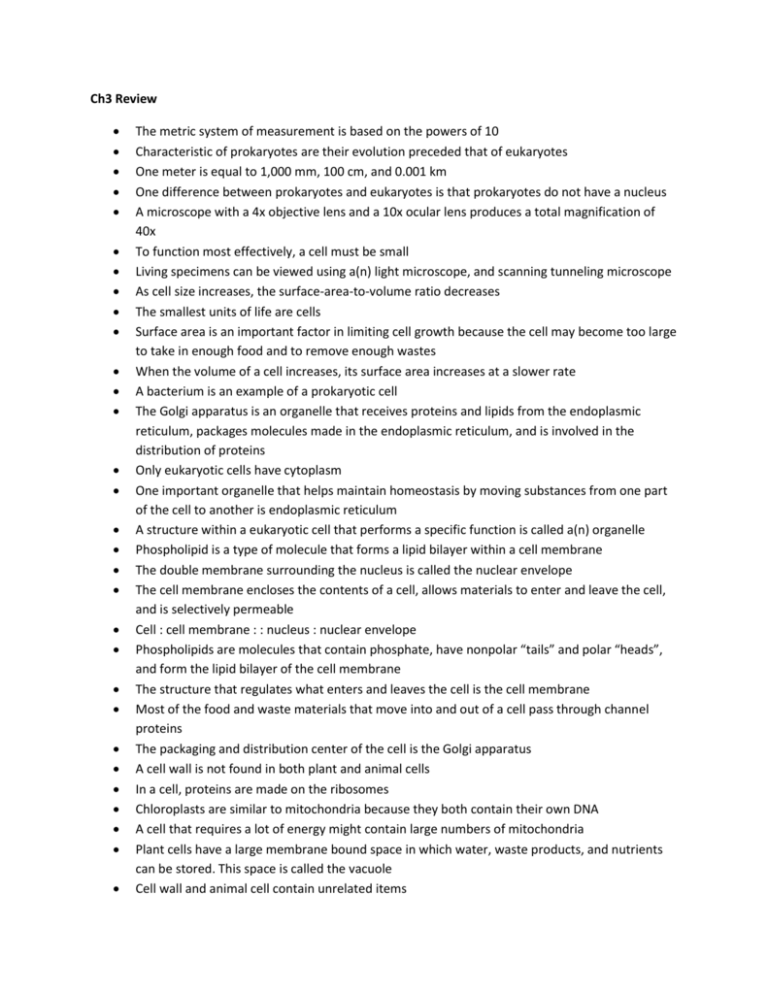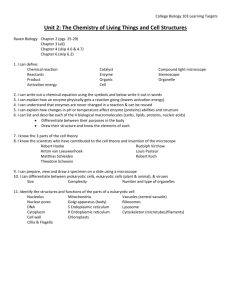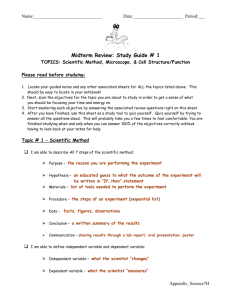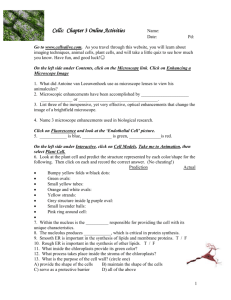Ch3 Review - Stephanie Dietterle Webpage
advertisement

Ch3 Review The metric system of measurement is based on the powers of 10 Characteristic of prokaryotes are their evolution preceded that of eukaryotes One meter is equal to 1,000 mm, 100 cm, and 0.001 km One difference between prokaryotes and eukaryotes is that prokaryotes do not have a nucleus A microscope with a 4x objective lens and a 10x ocular lens produces a total magnification of 40x To function most effectively, a cell must be small Living specimens can be viewed using a(n) light microscope, and scanning tunneling microscope As cell size increases, the surface-area-to-volume ratio decreases The smallest units of life are cells Surface area is an important factor in limiting cell growth because the cell may become too large to take in enough food and to remove enough wastes When the volume of a cell increases, its surface area increases at a slower rate A bacterium is an example of a prokaryotic cell The Golgi apparatus is an organelle that receives proteins and lipids from the endoplasmic reticulum, packages molecules made in the endoplasmic reticulum, and is involved in the distribution of proteins Only eukaryotic cells have cytoplasm One important organelle that helps maintain homeostasis by moving substances from one part of the cell to another is endoplasmic reticulum A structure within a eukaryotic cell that performs a specific function is called a(n) organelle Phospholipid is a type of molecule that forms a lipid bilayer within a cell membrane The double membrane surrounding the nucleus is called the nuclear envelope The cell membrane encloses the contents of a cell, allows materials to enter and leave the cell, and is selectively permeable Cell : cell membrane : : nucleus : nuclear envelope Phospholipids are molecules that contain phosphate, have nonpolar “tails” and polar “heads”, and form the lipid bilayer of the cell membrane The structure that regulates what enters and leaves the cell is the cell membrane Most of the food and waste materials that move into and out of a cell pass through channel proteins The packaging and distribution center of the cell is the Golgi apparatus A cell wall is not found in both plant and animal cells In a cell, proteins are made on the ribosomes Chloroplasts are similar to mitochondria because they both contain their own DNA A cell that requires a lot of energy might contain large numbers of mitochondria Plant cells have a large membrane bound space in which water, waste products, and nutrients can be stored. This space is called the vacuole Cell wall and animal cell contain unrelated items The organelles associated with plant photosynthesis are the chloroplasts Scientists use metric units when taking measurements Electronic microscopes have higher magnifying power then light microscopes do A meter is a basic unit used when measuring length Total magnification of a light microscope is calculated by multiplying the magnification of the objective lens by the magnification of the ocular lens In a(n) light microscope, light passes through one or more lenses to produce an enlarged image of a specimen A compound microscope is a type of light microscope Resolution is a measure of the clarity of an image The ability to make an image appear larger than its actual size is called magnification While a light microscope uses light to visualize a specimen, electron microscopes use a(n) electron bean and a vacuum chamber Both plant cells and animal cells have cell membranes. In addition, plant cells are surrounded by a(n) cell wall A(n) electron microscope cannot be used to view living specimens Photosynthesis takes place in the chloroplasts of plant cells All cells arise from existing cells Rough endoplasmic reticulum has ribosomes embedded on its surface The basic unit of structure and function in an organism is the cell Eukaryotic cells have a system of internal membranes The statement that “cells arise only from existing cells” is part of the cell theory The organelles that are the site of protein synthesis in a cell are called ribosomes As a cell’s size decreases, its surface-area-to-volume ratio increases The nucleus houses a cell’s DNA, which contains heredity information Modern prokaryotes are generally known as bacteria A phospholipid is a molecule with a(n) polar head Eukaryotic cells contain specialized structures called organelles Proteins that aid in moving substances into and out of the cell are called transport proteins A cell with a well-defined nucleus surrounded by a nuclear envelope is a(n) eukaryotic cell Marker proteins on the surface of cells have carbohydrates attached to the protein The meshlike network of protein fibers that supports the shape of the cell is called the cytoskeleton All substances that enter or leave a cell must cross the cell membrane Scientists think that eukaryotic cells evolved about 1.5 billion years ago











